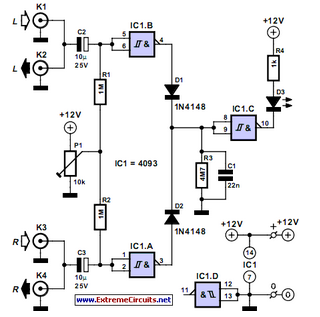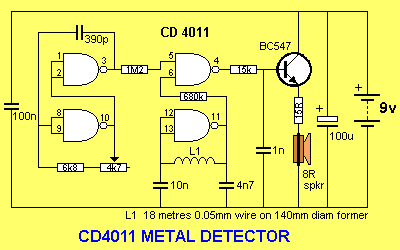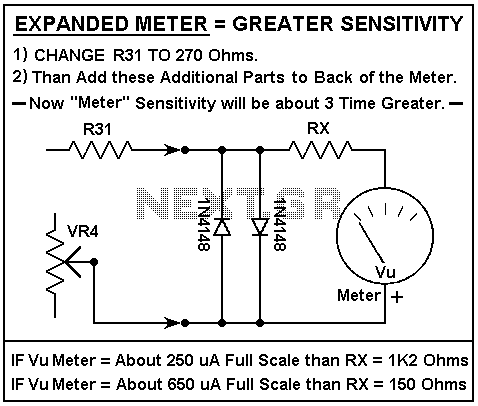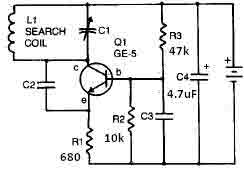
Proximity Detector
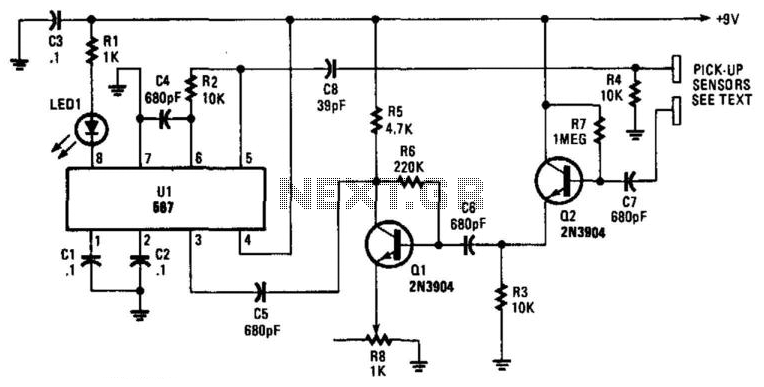
In this proximity detector, an NE567 tone decoder generates a signal of approximately 100 kHz, which is supplied to one sensor. The sensors can be made from copper or aluminum wires, plates, or any other suitable conductive material. When an object approaches the sensors, it results in an increase in capacitance between them. Transistors Q1 and Q2 amplify the signal and transmit it to U1. It is important to note that capacitor C8 and resistor R4 phase shift the VCO signal from the NE567, enabling U1 to detect its own output signal.
The described proximity detector circuit utilizes the NE567 tone decoder as the central component for generating and processing a 100 kHz signal. This signal is transmitted to conductive sensors, which can be constructed from materials such as copper or aluminum. The choice of conductive material is crucial, as it directly influences the effectiveness of the capacitance change detection mechanism.
When an object comes in proximity to the sensors, the capacitance between them increases due to the presence of the object. This change in capacitance is detected by the circuit, leading to the amplification of the signal by transistors Q1 and Q2. These transistors are configured to provide sufficient gain to ensure that the signal is strong enough to be processed by the next stage of the circuit, represented by U1.
The role of U1 is critical, as it is responsible for interpreting the amplified signal. The circuit also includes a phase-shifting network composed of capacitor C8 and resistor R4. This network adjusts the phase of the voltage-controlled oscillator (VCO) signal from the NE567, allowing U1 to effectively detect the output signal it generates. This phase shifting is essential for ensuring that the system operates reliably, as it aligns the timing of the signals for optimal detection performance.
Overall, this proximity detector circuit is designed to operate effectively in applications where the detection of nearby objects is required, utilizing a combination of capacitive sensing and signal amplification techniques to achieve reliable performance. In this proximity detector an NE567 tone decoder provides a signal of about 100 kHz that is fed to one sensor. The senso rs are copper or aluminum wires or plates, or any other suitable conductive material. When another object is near the sensors, it causes an increase in capacitance between the sensors. Ql and Q2 amplify the signal and feed it to Ul. Notice that C8 and R4 phase shift the VCO signal from the NE567 so that Ul can detect its own output signal.
The described proximity detector circuit utilizes the NE567 tone decoder as the central component for generating and processing a 100 kHz signal. This signal is transmitted to conductive sensors, which can be constructed from materials such as copper or aluminum. The choice of conductive material is crucial, as it directly influences the effectiveness of the capacitance change detection mechanism.
When an object comes in proximity to the sensors, the capacitance between them increases due to the presence of the object. This change in capacitance is detected by the circuit, leading to the amplification of the signal by transistors Q1 and Q2. These transistors are configured to provide sufficient gain to ensure that the signal is strong enough to be processed by the next stage of the circuit, represented by U1.
The role of U1 is critical, as it is responsible for interpreting the amplified signal. The circuit also includes a phase-shifting network composed of capacitor C8 and resistor R4. This network adjusts the phase of the voltage-controlled oscillator (VCO) signal from the NE567, allowing U1 to effectively detect the output signal it generates. This phase shifting is essential for ensuring that the system operates reliably, as it aligns the timing of the signals for optimal detection performance.
Overall, this proximity detector circuit is designed to operate effectively in applications where the detection of nearby objects is required, utilizing a combination of capacitive sensing and signal amplification techniques to achieve reliable performance. In this proximity detector an NE567 tone decoder provides a signal of about 100 kHz that is fed to one sensor. The senso rs are copper or aluminum wires or plates, or any other suitable conductive material. When another object is near the sensors, it causes an increase in capacitance between the sensors. Ql and Q2 amplify the signal and feed it to Ul. Notice that C8 and R4 phase shift the VCO signal from the NE567 so that Ul can detect its own output signal.

